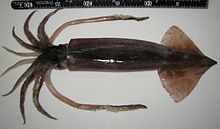
A squid is a mollusc with an elongated soft body, large eyes, eight arms, and two tentacles in the superorder Decapodiformes, though many other molluscs within the broader Neocoleoidea are also called squid despite not strictly fitting these criteria. Like all other cephalopods, squid have a distinct head, bilateral symmetry, and a mantle. They are mainly soft-bodied, like octopuses, but have a small internal skeleton in the form of a rod-like gladius or pen, made of chitin.

Amberjacks are Atlantic and Pacific fish in the genus Seriola of the family Carangidae. They are widely consumed across the world in various cultures, most notably for Pacific amberjacks in Japanese cuisine; they are most often found in the warmer parts of the oceans. There are many variations of amberjack, including greater amberjack (Atlantic), lesser amberjack (Atlantic), Almaco jack (Pacific), yellowtail (Pacific), and the banded rudderfish (Atlantic). Though most of the Seriola species are considered "amberjacks", the species Seriola hippos is not.
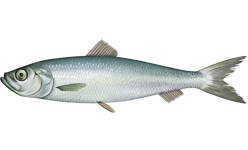
Atlantic herring is a herring in the family Clupeidae. It is one of the most abundant fish species in the world. Atlantic herrings can be found on both sides of the Atlantic Ocean, congregating in large schools. They can grow up to 45 centimetres (18 in) in length and weigh up to 1.1 kilograms (2.4 lb). They feed on copepods, krill and small fish, while their natural predators are seals, whales, cod and other larger fish.

Ommastrephidae is a family of squid containing three subfamilies, 11 genera, and over 20 species. They are widely distributed globally and are extensively fished for food. One species, Todarodes pacificus, comprised around half of the world's cephalopod catch annually.

The Humboldt squid, also known as jumbo squid or jumbo flying squid (EN), and Pota in Peru or Jibia in Chile (ES), is a large, predatory squid living in the eastern Pacific Ocean. It is the only known species of the genus Dosidicus of the subfamily Ommastrephinae, family Ommastrephidae.

The European squid or common squid is a large squid belonging to the family Loliginidae. It occurs abundantly in coastal waters from the North Sea to at least the west coast of Africa. This species lives from sea level to depths of 500 m (1,600 ft). Its mantle is up to 40 cm (16 in) long. The species is extensively exploited by commercial fisheries.

Thysanoteuthis rhombus, also known as the diamond squid,diamondback squid, or rhomboid squid, is a large species of squid from the family Thysanoteuthidae which is found worldwide, throughout tropical and subtropical waters. T. rhombus is given its name for the appearance of the fins that run the length of the mantle. They are a fast growing species with a lifespan of approximately 1 year. The diamond squid is the only cephalopod species known to be monogamous. T. rhombus often preys on fish and other small cephalopods at varying water depths. This species is commercially fished in Japan, specifically in the Sea of Japan and Okinawa.

Spawn is the eggs and sperm released or deposited into water by aquatic animals. As a verb, to spawn refers to the process of freely releasing eggs and sperm into a body of water ; the physical act is known as spawning. The vast majority of aquatic and amphibious animals reproduce through spawning. These include the following groups:
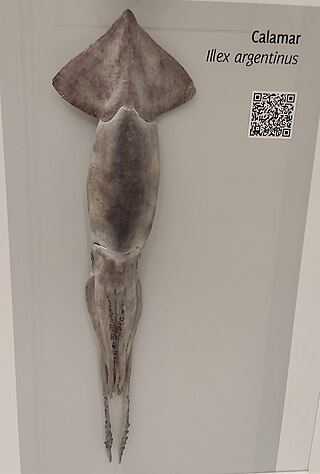
Illex argentinus, commonly known as the Argentine shortfin squid, is a species of squid in the family Ommastrephidae from the south western Atlantic Ocean.

The neon flying squid, sometimes called the red flying squid, akaika, and red squid is a species of large flying squid in the family Ommastrephidae. They are found in subtropical and temperate oceanic waters globally.

Todarodinae is a squid subfamily in the family Ommastrephidae.

Illex illecebrosus, commonly known as the northern shortfin squid, is a species of neritic squids in the family Ommastrephidae. Squids of the genus Illex account for 65% of the world's cephalopod captures. Illex is formed by four taxa distributed throughout the Atlantic Ocean, whose identification and phylogenetic relationships based on morphological characters remain controversial.They are found in the northwest Atlantic Ocean, from off the coast of eastern North America to Greenland, Iceland, and west of Ireland and the United Kingdom. They are a highly migratory and short-lived species, with lifespans of less than a year. They are commercially important and are fished extensively, mostly for the Canadian and Japanese markets.

The purpleback flying squid or purpleback squid is a species of cephalopod in the family Ommastrephidae, occurring in the Indo-Pacific. It is considered one of the most abundant large squids.
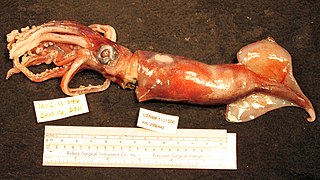
Ornithoteuthis antillarum, the Atlantic bird squid, is a species of flying squid from the family Ommastrephidae which is found in the warmer waters of the Atlantic Ocean. This species is an important component of the diet of many species of fish and of cetaceans. It is taken as a bycatch in fisheries but has the potential to be commercially important if appropriate fishing methods can be developed.
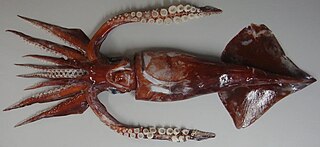
Todarodes is a genus of flying squid from the subfamily Todarodinae, of which it is the type genus. The genus contains five species which are partially allopatric but between them their distributions encompass most of the world's oceans and seas. These squid have a funnel groove with foveola, a hectocotylised fourth arm and tentacular stalks which lack free trabeculae.
The Angolan flying squid is a species of squid from the subfamily Todarodinae, part of the family Ommastrephidae. Due to taxonomic confusion with the Antarctic flying squid the exact limits of its distribution are uncertain but it is thought to be restricted to waters off Southern Africa.

The Antarctic flying squid is a species of squid from the subfamily Todarodinae of the family Ommastrephidae, a family of pelagic squid from the order Oegopsida. It has a circumglobal distribution in the seas around the lower latitudes of the Southern Ocean.
The little flying squid is a species of squid, one of the arrow squids of the genus Todarodes, in the subfamily Todarodinae of the flying squid family Ommastrephidae. It is a small species from the waters around northern Australia and Indonesia.

The European flying squid is a species of squid from the continental slope and oceanic waters of the eastern Atlantic Ocean and the Mediterranean Sea. It is the type species of the genus Todarodes, the type genus of the subfamily Todarodinae of the pelagic squid family Ommastrephidae. It is a species which is targeted by some fisheries, although it is more often a bycatch.

Nototodarus gouldi, also known as the Gould's squid, Gould's flying squid, or arrow squid, is a squid belonging to the family Ommastrephidae. It inhabits the tropical and temperate waters of Australia and New Zealand. It is frequently caught and eaten for food. They live up to one year.
